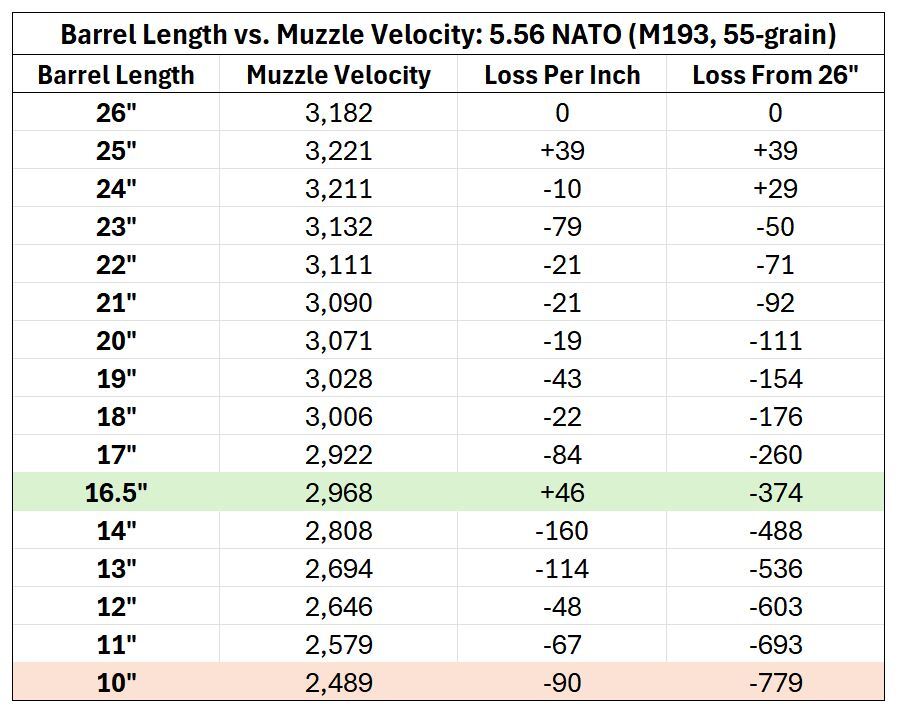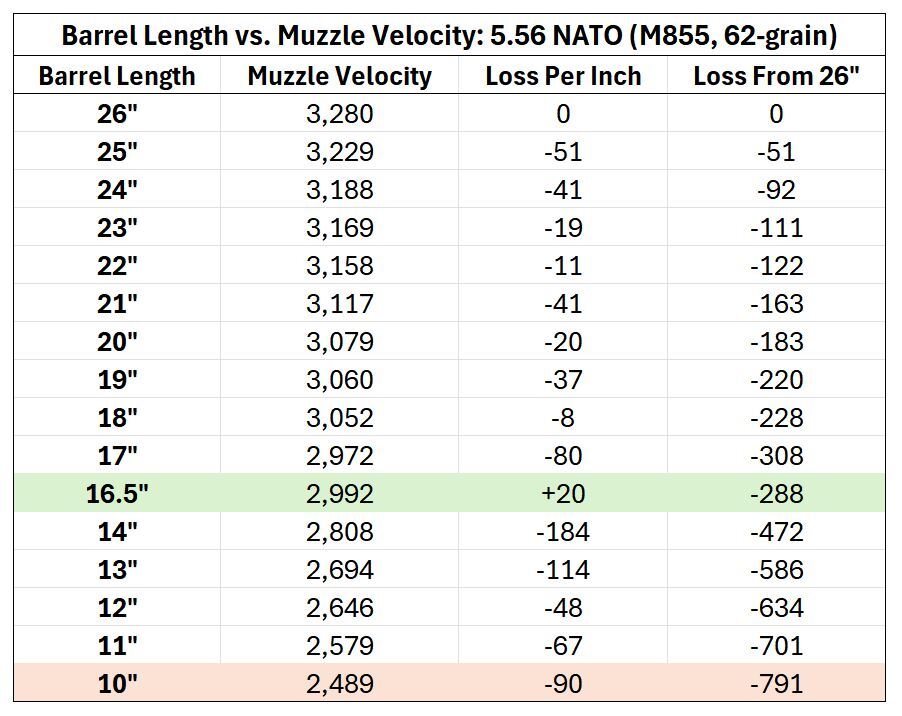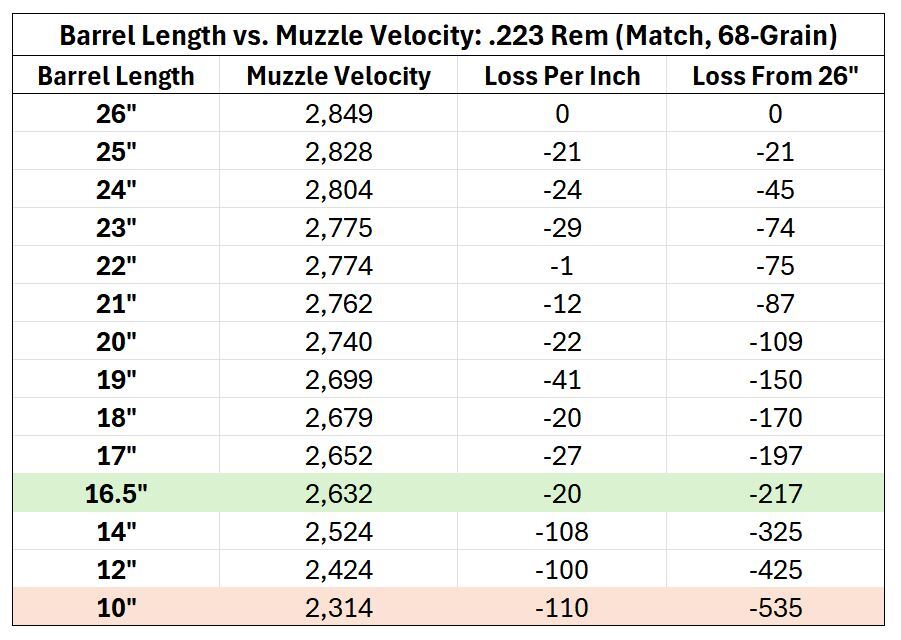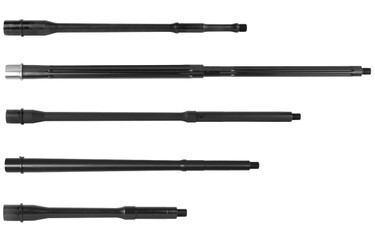The Best Barrel Length for 5.56/.223 (With Ballistic Data)
Posted by 80-Lower.com on Jul 23rd 2025
The .223 Remington and 5.56 NATO cartridges are based on the .222 Remington, an old varmint hunting round designed to be fired from a bolt-action rifle. That rifle was the Remington Model 721, to be exact, which had a 24" barrel.
In other words, the 5.56 and .223 cartridges we all chamber in our AR-15s were, in fact, meant to be fired from guns with long barrels. The M16 was made to have a 20" barrel. But the modern AR-15 is supposed to be a compact, lightweight gun. No long barrels allowed, lest you suffer scoffs and jeers from Mk 18 LARPers.
So, finding the best barrel length for 5.56 and .223 means finding the shortest barrel leng that still produces optimal ballistic performance. What is the best barrel length? We've got the answer (spoilers: it's 16" for performance, and 11" for SBRs), complete with lots of ballistic data to show why that's the case.
Defining What "The Best Length" Means
Since we're compromising on two opposing things -- barrel length, and ballistic performance -- we need to define what "best" even means. There are two ways to define this:
First, for the sake of hunting and self defense: The best barrel length for 5.56 and .223 is one that produces a muzzle velocity well above 2,500 FPS. That's because, according to testing data [1], that's the velocity needed for 5.56 NATO to produce a lethal wound channel.
Second, for the sake of accuracy and overall performance: The best barrel length is one that produces nearly maximum muzzle velocity with the shortest length possible. In our opinion, a loss of no more than 10% of maximum velocity constitutes an optimal barrel length.
5.56/.223 Velocity vs. Barrel Length Charts
With our standard for what "the best barrel length" generally means in mind, let's look at the muzzle velocities produced by the most popular 5.56 and .223 loads: M193 (55-grain), M855 (62-grain), and Black Hills Match (68-grain) ammo.
55-Grain (M193) 5.56 NATO

Here we see the maximum velocity achieved with 55-grain 5.56 NATO is 3,211 FPS using a 24" barrel. It's important to note that increasing length to 26" actually decreases velocity to 3,182 FPS.
If we apply our 90%-of-maximum-velocity standard for optimal performance, we find that we need a muzzle velocity of at least 2,889 FPS. In this case, a 16" barrel is the best length. It produces a muzzle velocity of 2,968 -- well above both the 90% minimum, and 468 FPS above the velocity needed for high lethality.
Note the half-inch difference in barrel length (16.5") is due to the length the test barrel was cut to when collecting data.
62-Grain (M855) 5.56 NATO

When it comes to the heavier 62-grain 5.56 NATO load, the results change little. Maximum velocity is found to be 3,280 FPS with a 26" barrel, and applying our standards for optimal performance means that we need a muzzle velocity of at least 2,952 FPS.
Once again, 16" is the best barrel length. It yields a muzzle velocity of 2,992 FPS, again far above the 2,500 FPS minimum for lethality and more than 90% of the maximum.
68-Grain (Black Hills Match) .223 Remington

What about heavy match-grade ammo? For a third time, the results remain nearly identical. The maximum muzzle velocity of 2,849 FPS is achieved with a 26" barrel and 90% of that velocity means we need at least 2,564 FPS.
No surprise: The 16" barrel produces the optimal velocity, yielding 2,632 FPS.
What About Short-Barreled Rifles?
It is true that short-barreled rifles chambered in 5.56 NATO and .223 Remington have become very popular for both military and civilian use.
If we look at the same ballistic data and apply the minimum muzzle velocity for effective wounding we find that, for M193 and M855 ammo, the shortest barrel length we can use is 11".
An 11" barrel is just long enough to provide slightly more than the 2,500 FPS needed for high lethality at short distances -- usually within 100 to 200 yards, at most -- while going any shorter yields muzzle velocities below 2,500 FPS.
But 11" is a relatively uncommon barrel length; the barrel used to collect the testing data above was simply cut in 1" intervals. So, most AR-15 owners who are interested in short-barreled configurations opt for an 11.5" barrel. This length has become a popular choice for special operators employing the new URG-I upper receiver group.
Want to Maximize Your Performance?
Now that we've covered the best barrel lengths for 5.56 and .223, you're probably looking at configuring your AR for maximum performance. Check out our new upper receivers. We've got many high-quality 16" uppers available with 4150 CMV barrels that produce sub-MOA performance.
Not sure whether to go with chrome lining or nitride? Read our next guide: Which AR-15 Barrel Finish is Best?
DISCLAIMER: If you are new to the world of DIY gun building, you likely have a lot of questions and rightfully so. It’s an area that has a lot of questions that, without the correct answers, could have some serious implications. At GunBuilders.com, we are by no means providing this content on our website to serve as legal advice or legal counsel. We encourage each and every builder to perform their own research around their respective State laws as well as educating themselves on the Federal laws. When performing your own research, please be sure that you are getting your information from a reliable source.

